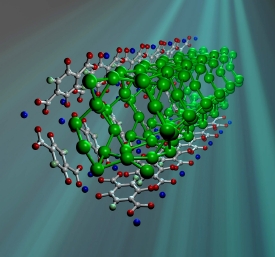Apr 3 2008
One of the key engineering challenges to building a clean, efficient, hydrogen-powered car is how to design the fuel tank.
 MOF-74 resembles a series of tightly packed straws comprised mostly of carbon atoms (white balls) with columns of zinc ions (blue balls) running down the walls. Heavy hydrogen molecules (green balls) adsorbed in MOF-74 pack into the tubes more densely than they would in solid form.
MOF-74 resembles a series of tightly packed straws comprised mostly of carbon atoms (white balls) with columns of zinc ions (blue balls) running down the walls. Heavy hydrogen molecules (green balls) adsorbed in MOF-74 pack into the tubes more densely than they would in solid form.
Storing enough raw hydrogen for a reasonable driving range would require either impractically high pressures for gaseous hydrogen or extremely low temperatures for liquid hydrogen. In a new paper researchers at the National Institute of Standards and Technology's Center for Neutron Research (NCNR) have demonstrated that a novel class of materials could enable a practical hydrogen fuel tank.
A research team from NIST, the University of Maryland and the California Institute of Technology studied metal-organic frameworks (MOFs). One of several classes of materials that can bind and release hydrogen under the right conditions, they have some distinct advantages over competitors. In principle they could be engineered so that refueling is as easy as pumping gas at a service station is today, and MOFs don't require the high temperatures (110 to 500 C) some other materials need to release hydrogen.
In particular, the team examined MOF-74, a porous crystalline powder developed at the University of California at Los Angeles. MOF-74 resembles a series of tightly packed straws comprised of mostly carbon atoms with columns of zinc ions running down the inside walls. A gram of the stuff has about the same surface area as two basketball courts.
The researchers used neutron scattering and gas adsorption techniques to determine that at 77 K (-196 C), MOF-74 can adsorb more hydrogen than any unpressurized framework structure studied to date"ªpacking the molecules in more densely than they would be if frozen in a block.
NCNR scientist Craig Brown says that, though his team doesn't understand exactly what allows the hydrogen to bond in this fashion, they think the zinc center has some interesting properties.
"When we started doing experiments, we realized the metal interaction doesn't just increase the temperature at which hydrogen can be stored, but it also increases the density above that in solid hydrogen," Brown says. °This is absolutely the first time this has been encountered without having to use pressure."
Although the liquid-nitrogen temperature of MOF-74 is not exactly temperate, it's easier to reach than the temperature of solid hydrogen (-269 C), and one of the goals of this research is to achieve energy densities great enough to be as economical as gasoline at ambient, and thus less costly, temperatures. MOF-74 is a step forward in terms of understanding energy density, but there are other factors left to be dealt with that, once addressed, could further increase the temperature at which the fuel can be stored. Fully understanding the physics of the interaction might allow scientists to develop means for removing refrigeration or insulation, both of which are costly in terms of fuel economy, fuel production, or both.